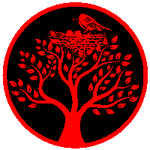Just to clarify, dote-mimi and uchikaeshi-mimi can both apply, since the first term simply describes the rising of the border, the second term refers to the way the border was obtained (but in this tsuba the rised border could have been obtained by a tomogane-fukurin - 共金覆輪, i.e. a fukurin made of the same iron). About the ji-sukashi tsuba, my guess is Akasaka. Bye, Mauro


